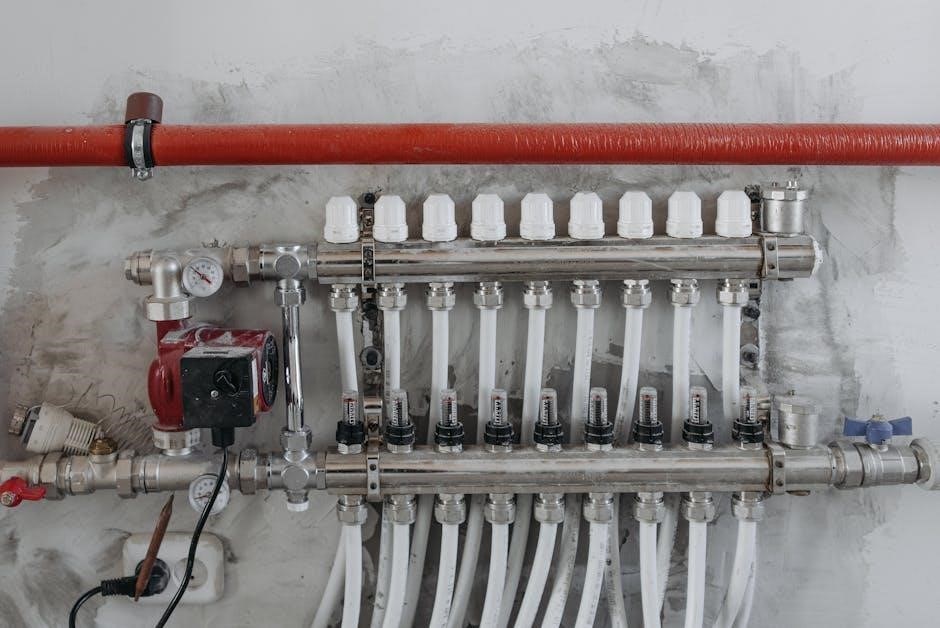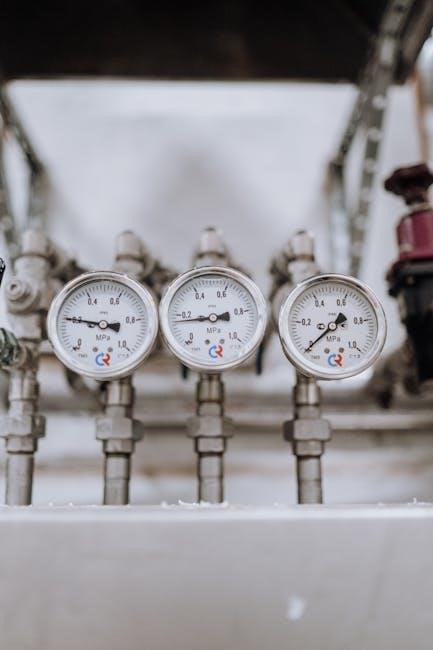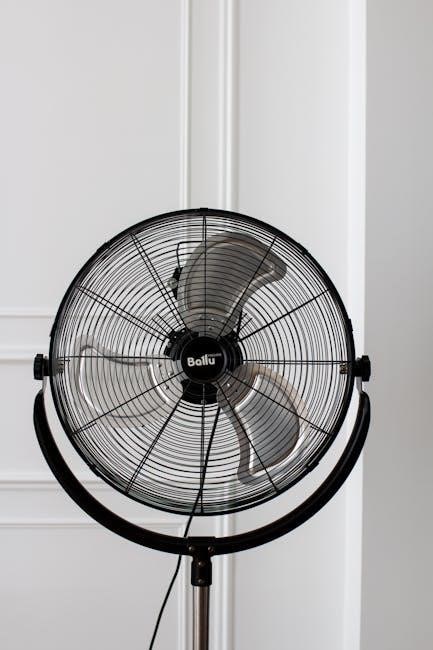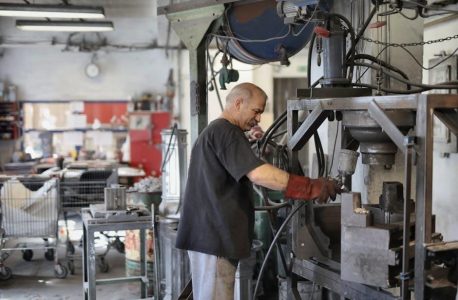HVAC manifold gauges are essential tools for diagnosing and servicing heating, ventilation, and air conditioning systems. They measure pressure and temperature, ensuring system performance and safety, crucial for effective maintenance and repair.
What Are HVAC Manifold Gauges?
HVAC manifold gauges are tools used to measure pressure and temperature in heating, ventilation, and air conditioning systems. They consist of two gauges: one for high-pressure (red port) and one for low-pressure (blue port) sides. These gauges are connected to the system via hoses and provide precise readings to diagnose and service HVAC systems. They are essential for technicians to ensure proper system operation, detect leaks, and maintain optimal performance. The gauges must match the refrigerant type to deliver accurate readings, making them a critical component in HVAC diagnostics and maintenance.
Importance of Manifold Gauges in HVAC Systems
Manifold gauges are vital for ensuring HVAC system efficiency and safety. They provide accurate pressure and temperature readings, enabling technicians to diagnose issues, such as leaks or refrigerant imbalances. Proper use of these gauges helps maintain optimal system performance, prevents premature wear, and ensures compliance with safety standards. They are indispensable for both installation and routine maintenance, making them a cornerstone tool in the HVAC industry for delivering reliable and effective service.
Types of HVAC Manifold Gauges
HVAC manifold gauges are categorized based on compatibility with refrigerants like R-22, R-410A, and R-134a. Each type features specific pressure scales to match the refrigerant’s properties. Digital gauges offer precise readings, while analog versions are cost-effective and reliable. Selecting the right gauge ensures accurate measurements and safe operation, preventing system damage and maintaining efficiency. Proper matching is crucial for optimal performance and adherence to safety protocols in HVAC applications.

Understanding the Components of HVAC Manifold Gauges
HVAC manifold gauges consist of high-pressure (red) and low-pressure (blue) ports, hoses, and gauge scales. These components work together to measure refrigerant pressure and temperature accurately, enabling precise system diagnosis and maintenance.
High-Pressure Side (Red Port)
The high-pressure side, marked by the red port, measures discharge pressure from the compressor. It connects to the system’s high-pressure service port, typically on the condenser or receiver. The red port is crucial for diagnosing issues like overcharging or restricted airflow. Always use gauges compatible with the refrigerant type to ensure accurate readings. Proper connection and safety practices are essential to avoid system damage or personal injury. Regularly inspect the red port and hoses for leaks or damage to maintain reliability and performance during HVAC service operations.
Low-Pressure Side (Blue Port)
The low-pressure side, identified by the blue port, measures suction pressure from the compressor. It connects to the system’s low-pressure service port, usually on the evaporator. The blue port helps diagnose issues like undercharging or refrigerant leaks. Always ensure the gauges match the refrigerant type for accurate readings. Proper connection and safety practices are vital to prevent system damage or personal injury. Regularly inspect the blue port and hoses for wear or leaks to maintain reliable performance during HVAC system servicing and diagnostics.
Gauge Scales and Refrigerant Types
Gauge scales are calibrated for specific refrigerants, ensuring accurate pressure and temperature readings. Common refrigerants like R-410A, R-134a, and R-22 have unique pressure-temperature relationships. Using mismatched gauges can lead to incorrect readings. The scales display pressure in psig or metric units, with numbered markers indicating saturation temperatures for each refrigerant. Proper matching ensures precise diagnostics and safe system operation. Always verify the refrigerant type before connecting gauges, as incorrect pairing can result in errors or system damage. This alignment is critical for accurate HVAC system performance analysis and maintenance.

Assembling the Manifold Gauge Set
Connect the high-pressure hose to the red port and the low-pressure hose to the blue port. Ensure hand valves are closed and check for leaks before use.
Connecting the High-Pressure Hose
To connect the high-pressure hose, attach it to the red port on the manifold gauge set. Ensure the valve is closed before securing the connection. Tighten the fitting firmly to prevent leaks. Use Teflon tape on threaded connections for a secure seal. Double-check the connection by applying a small amount of pressure. Always wear protective gear, such as gloves and safety goggles, when handling high-pressure components. Proper connection ensures accurate pressure readings and safe operation during HVAC system servicing.
Connecting the Low-Pressure Hose
Attach the low-pressure hose to the blue port on the manifold gauge set. Ensure the valve is closed before connecting to prevent refrigerant loss. Use Teflon tape on threaded connections for a leak-tight seal. Gently tighten the fitting to avoid damage. Once connected, perform a leak check by applying a small amount of pressure. Always wear protective gear, such as gloves and safety goggles, when handling the low-pressure side. Proper connection ensures accurate readings and safe operation during HVAC system diagnostics and servicing.
Ensuring Proper Sealing and Safety
Proper sealing is critical to prevent refrigerant leaks and ensure accurate pressure readings. Use Teflon tape on all threaded connections to create a leak-tight seal. Inspect hoses and fittings for damage or wear before use. Always perform a leak test by applying a small amount of pressure to the connections. Safety is paramount; wear gloves and safety goggles when handling the manifold gauges and refrigerant lines. Proper sealing and safety practices protect both the technician and the HVAC system from potential hazards during servicing or diagnostics.

Safety Precautions When Using Manifold Gauges
Always wear protective gear, including gloves and safety goggles, when handling manifold gauges. Ensure the system is properly prepared and check for leaks before use to maintain safety and prevent accidents.
Wearing Protective Gear
Wearing protective gear is crucial when using manifold gauges to ensure personal safety. Always wear gloves to prevent hand injuries from sharp connections or sudden pressure releases. Safety goggles or glasses protect eyes from refrigerant leaks or debris. A face mask is recommended to avoid inhaling harmful refrigerant fumes. Steel-toe boots and insulating sleeves can provide additional protection in hazardous environments. Proper attire helps prevent accidents and ensures compliance with safety standards, making it a vital practice for HVAC technicians working with manifold gauges.
Preparing the System for Gauge Connection
Before connecting manifold gauges, ensure the HVAC system is powered off to prevent accidental start-ups. Remove protective caps from service ports and inspect for leaks. Connect the low-pressure hose to the compressor’s suction side and purge non-condensible gases to avoid contamination. Ensure manifold valves are closed to prevent refrigerant release. Follow safety guidelines to protect yourself and the equipment, ensuring accurate readings and system integrity during the servicing process.
Checking for Leaks Before Use
Before connecting manifold gauges, inspect the system and hoses for leaks. Use a wet cloth to detect refrigerant leaks, as they will bubble at leak points. Ensure all connections are tight and valves are closed. Connect the vacuum pump to the low-pressure side and monitor the gauge for pressure drops, which indicate leaks. Address any issues before proceeding to maintain system integrity and ensure accurate pressure readings during servicing.

Operating the HVAC Manifold Gauges
Connect the gauges to the system ports, ensuring proper alignment of high and low-pressure hoses. Open the valves slowly to avoid pressure surges, then monitor and record readings accurately for diagnostics and servicing.
Setting Up the Gauges
Begin by ensuring all hand valves on the manifold gauge set are in the closed position. Wear protective gear, including gloves and safety goggles, to prevent accidents. Next, remove the protective caps from the system ports and inspect for leaks. Connect the high-pressure (red) and low-pressure (blue) hoses to their respective ports, ensuring a secure fit. Turn the power off to the HVAC system before proceeding. Open the access valves on the manifold gauge set slowly to avoid sudden pressure changes. This setup ensures safe and accurate pressure readings for diagnostics and servicing. Always refer to the manufacturer’s guide for specific refrigerant compatibility and setup instructions.
Connecting the Hoses to Service Ports
Connect the red hose to the high-pressure service port and the blue hose to the low-pressure port. Ensure all connections are secure to prevent leaks. Turn the system off before attaching hoses to avoid pressure surges. Verify the ports are clean and free of debris. Use the correct adapters for compatibility with the system. Double-check that the gauges match the refrigerant type for accurate readings. Always follow the manufacturer’s instructions for specific connection procedures. Proper hose connection ensures reliable data for diagnosing and servicing the HVAC system effectively.
Reading and Interpreting Pressure Readings
Reading and interpreting pressure readings on HVAC manifold gauges involves understanding the high-pressure (red) and low-pressure (blue) sides. The red port measures high-pressure levels, while the blue port indicates low-pressure readings. Refer to the gauge scales specific to the refrigerant type, as they vary for R-410A, R-134a, and R-22. Use the saturation temperature chart on the gauge to cross-reference pressure readings with temperature levels. Ensure accurate readings by purging non-condensible gases and maintaining proper system conditions. Always compare measured pressures to the system’s recommended operating parameters to identify potential issues efficiently.

Maintenance and Care of Manifold Gauges
Regularly clean gauges with a wet cloth and mild detergent, avoiding harsh chemicals. Inspect hoses for damage and store the set properly in a protective case to ensure longevity and accuracy.
Cleaning the Gauges and Connections
Clean gauges and connections with a damp cloth and mild detergent, avoiding harsh chemicals. Gently wipe surfaces, ensuring no liquid enters internal components. Dry thoroughly with a clean cloth, especially copper parts, to prevent corrosion. Regular cleaning prevents grime buildup and maintains accuracy. Avoid abrasive materials to prevent scratching. Inspect for corrosion or damage after cleaning. Use specialized HVAC cleaning products if available. Consistent maintenance ensures proper function and longevity of the manifold gauges.
Checking Hose Condition
Examine hoses for cracks, damage, or wear before each use. Replace any compromised hoses to prevent leaks and ensure safe operation. Look for signs of aging or chemical exposure. Check connections for tightness and integrity. Regular inspections help maintain system performance and safety. Replace hoses every few years or as recommended by the manufacturer. Properly maintained hoses are crucial for accurate pressure readings and reliable service.
Storing the Manifold Gauge Set Properly
Store the manifold gauge set in a clean, dry place to protect it from damage. Use protective caps to cover ports and hoses, preventing dust and moisture buildup. Avoid exposure to extreme temperatures or direct sunlight. Before storage, ensure all connections are clean and dry. Check hoses for damage and store them separately to prevent kinking. Keep the set in a sturdy case or box to avoid accidental damage. Proper storage ensures longevity and maintains the accuracy of the gauges for future use. Regularly inspect stored equipment for signs of wear or deterioration.

Troubleshooting Common Issues
Identify leaks by checking connections and hoses. Verify refrigerant compatibility with gauges. Inspect for blockages or faulty valves. Addressing these issues ensures accurate readings and system performance.
Identifying Leaks in the System
Identifying leaks is critical for maintaining HVAC system efficiency. Use soapy water to check connections and hoses for bubbles, indicating leaks. Ensure all valves are tightly closed and inspect manifold ports. Turn off the system before testing. Apply mild detergent to suspected areas and monitor for bubble formation. Verify that refrigerant type matches the gauge setup to avoid contamination. Regular leak checks prevent refrigerant loss and ensure accurate pressure readings, which are vital for system performance and safety. Always follow safety protocols during inspections.
Addressing Incorrect Pressure Readings
Incorrect pressure readings can occur due to improper gauge setup or mismatched refrigerant types. Ensure the manifold gauges are calibrated and compatible with the refrigerant used. Verify that the high-pressure (red) and low-pressure (blue) hoses are connected correctly. Check for blockages or kinks in the hoses, which can restrict airflow. If readings remain inconsistent, recalibrate the gauges or replace them if necessary. Always refer to the manufacturer’s guidelines for troubleshooting. Accurate pressure readings are vital for diagnosing and servicing HVAC systems effectively;
Resolving Connection Problems
Connection issues with manifold gauges can disrupt HVAC system diagnosis. Ensure all fittings are tightly secured and free from debris. Use Teflon tape on threaded connections to prevent leaks. If a connection feels loose, tighten it gently to avoid damaging threads. Check for blockages in hoses and service ports, and clean them if necessary. Apply a small amount of refrigerant oil to O-ring seals for a better connection. If leaks persist, inspect the hoses and replace any damaged sections. Always turn off the system before attempting repairs to ensure safety and proper sealing.
Advanced Techniques for Using Manifold Gauges
Master advanced techniques like system evacuation, charging, and purging non-condensible gases to optimize HVAC performance and ensure efficient system operation and longevity.
Using Gauges for System Evacuation
Manifold gauges are crucial for system evacuation, ensuring removal of air and moisture. Connect the vacuum pump to the low-pressure port, then monitor the gauge for a stable vacuum. Use the high-pressure gauge to confirm proper evacuation. Ensure all valves are sealed to prevent non-condensible gases from re-entering. Always wear safety gear and follow proper setup procedures to achieve optimal system performance and prevent damage.
Charging the System with Gauges
Charging the system with gauges ensures proper refrigerant levels. Connect the low-pressure hose to the refrigerant source and open the valve. Monitor the gauges to maintain optimal pressure levels. Use the high-pressure gauge to verify system performance. Add refrigerant in small increments, checking the gauges for stable readings. Ensure the system operates within manufacturer specifications. Proper charging with gauges prevents overcharging and ensures efficient system operation. Always follow safety guidelines and manufacturer instructions for accurate results.
Purging Non-Condensible Gases
Purging non-condensible gases, like air, is crucial for system efficiency. Connect the vacuum pump to the low-pressure port and open the valve. Monitor the gauges for pressure stabilization. Once vacuum is achieved, close the valve and disconnect the pump. Repeat if necessary to ensure all non-condensible gases are removed. Proper purging prevents high head pressure and ensures accurate refrigerant flow. Always follow safety guidelines and manufacturer instructions for effective purging. This step is essential for maintaining optimal system performance and preventing potential damage.
Selecting the Right Manifold Gauges for Your System
Choose gauges matching your system’s refrigerant type, like R-410A or R-134a, and ensure compatibility with system pressure requirements. Evaluate accuracy, durability, and ease of use for reliable performance.
Matching Gauges to Refrigerant Type
Matching manifold gauges to the correct refrigerant type is crucial for accurate pressure and temperature readings. Common refrigerants like R-410A, R-134a, and R-22 require specific gauges. Always check the system’s refrigerant label to ensure compatibility. Using mismatched gauges can lead to incorrect readings, potentially damaging the system. Gauges are designed with scaled pressure readings for each refrigerant type, ensuring precise measurements. Proper matching guarantees safe and efficient HVAC system diagnosis and maintenance, preventing costly errors and ensuring optimal performance.
Considering System Pressure Requirements
When selecting HVAC manifold gauges, it’s essential to consider the system’s pressure requirements. Gauges are designed to handle specific pressure ranges, ensuring accurate measurements without damage. Residential systems typically operate at lower pressures, while commercial systems may require gauges rated for higher pressures. Always verify the system’s specifications to match the appropriate gauge. Mismatched gauges can lead to inaccurate readings or equipment damage. Properly aligned pressure capabilities ensure safe and effective system servicing, maintaining reliability and performance in various HVAC applications.
Evaluating Gauge Accuracy and Durability
Evaluating the accuracy and durability of HVAC manifold gauges is crucial for reliable system diagnostics; High-quality gauges provide precise pressure and temperature readings, ensuring accurate system assessments. Durable materials, such as stainless steel or heavy-duty components, enhance longevity and resistance to harsh working conditions. Look for gauges certified by reputable organizations, as they meet strict performance standards. Regular calibration is also essential to maintain accuracy. By prioritizing durability and precision, technicians can rely on their gauges for consistent, dependable results in various HVAC applications and environments.
Mastering HVAC manifold gauges is vital for efficient diagnostics and system maintenance. Proper use ensures safety, accuracy, and optimal HVAC performance, requiring continuous learning and adherence to best practices.
HVAC manifold gauges are indispensable for diagnosing and maintaining HVAC systems. Proper assembly involves connecting high-pressure (red) and low-pressure (blue) hoses. Always match gauges to the refrigerant type for accurate readings. Safety measures include wearing protective gear and checking for leaks. Regular maintenance, such as cleaning gauges and inspecting hoses, ensures longevity. Correct usage enhances system performance and safety. By following best practices and staying informed, technicians can effectively utilize manifold gauges for precise diagnostics and efficient repairs.
Best Practices for Effective Use
Always connect high-pressure (red) and low-pressure (blue) hoses correctly to avoid system damage. Wear safety goggles and gloves when handling refrigerants. Ensure proper sealing and purge non-condensable gases before use. Regularly inspect hoses for wear and tear, replacing them as needed. Use gauges compatible with the refrigerant type for accurate readings. Refer to the service manual for specific instructions. Clean gauges and connections with mild detergents to maintain accuracy. Store the set properly after use to extend its lifespan and reliability.
Continuing Education and Skill Development
Continuing education is vital for mastering HVAC manifold gauges. Enroll in workshops or online courses to stay updated on new techniques and tools. Practice regularly to improve proficiency in reading pressures and diagnosing system issues. Stay informed about industry standards and advancements in refrigerant technology. Engage with professional communities to share knowledge and gain insights. Regularly review service manuals and manufacturer guidelines to refine your skills. Invest in hands-on training to enhance your ability to troubleshoot and maintain HVAC systems effectively.

